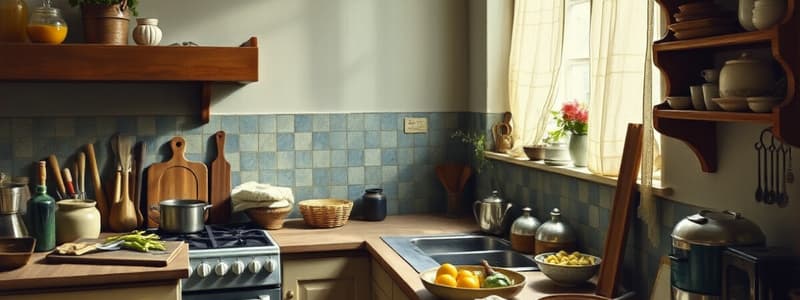Podcast
Questions and Answers
What is the benefit of regularly checking expiration dates in the pantry?
What is the benefit of regularly checking expiration dates in the pantry?
- It allows for the use of expired items in cooking.
- It helps to create a mess-free environment.
- It promotes freshness by using the FIFO method. (correct)
- It avoids the need for labeling food items.
What should be stored at eye level in kitchen cabinets?
What should be stored at eye level in kitchen cabinets?
- Infrequently used items.
- Seasonal kitchen tools.
- Heavy pots and pans.
- Frequently used items. (correct)
How can minimal clutter be achieved on countertops?
How can minimal clutter be achieved on countertops?
- By placing all appliances on the counter.
- By using decorative items frequently.
- By adding more cutting boards to the counter.
- By keeping only essential appliances and tools. (correct)
What is a recommended practice for organizing the refrigerator?
What is a recommended practice for organizing the refrigerator?
What is the purpose of using dividers in kitchen drawers?
What is the purpose of using dividers in kitchen drawers?
What strategy can be effective for maintaining organization in the kitchen?
What strategy can be effective for maintaining organization in the kitchen?
What is one tool that can help with kitchen organization?
What is one tool that can help with kitchen organization?
Why is consistent kitchen organization important?
Why is consistent kitchen organization important?
Flashcards are hidden until you start studying
Study Notes
Kitchen Organization
Importance of Kitchen Organization
- Enhances efficiency in meal preparation.
- Reduces stress and time spent searching for items.
- Promotes cleanliness and hygiene.
Key Areas to Organize
-
Pantry
- Categorization: Group similar items (grains, canned goods, snacks).
- Labeling: Use labels for easy identification.
- Expiration Dates: Regularly check and rotate items; use FIFO (First In, First Out) method.
-
Cabinets
- Accessibility: Store frequently used items at eye level.
- Dividers and Organizers: Use bins, shelves, or pull-out drawers for better space utilization.
- Seasonal Items: Keep infrequently used items at the back or on higher shelves.
-
Countertops
- Minimal Clutter: Keep only essential appliances and tools on the counter.
- Knife Block or Magnetic Strips: Store knives safely and within reach.
- Cutting Boards: Designate a space for cutting boards to prevent mess.
-
Refrigerator
- Zones: Create specific areas for different food types (dairy, produce, leftovers).
- Clear Containers: Use containers to keep similar items together and visible.
- Temperature Check: Ensure proper cooling settings for food safety.
-
Drawers
- Utensils: Use dividers for cooking utensils, measuring tools, and gadgets.
- Specialty Tools: Store specialty items like peelers or zesters separately.
- Baking Supplies: Keep baking tools and ingredients in a designated drawer.
Tips for Maintaining Organization
- Regular Decluttering: Schedule time to remove expired or unused items.
- Weekly Check: Assess pantry and fridge contents to ensure organization is maintained.
- Involve Family Members: Encourage everyone to return items to their designated places.
Additional Tools
- Storage Containers: Invest in clear, stackable containers for bulk items.
- Magnetic Organizers: Use for storing spices or small tools on walls.
- Rolling Carts: Utilize for flexible storage that can be moved as needed.
Conclusion
- Consistent organization leads to a more functional and enjoyable kitchen environment. Regular maintenance is essential for long-term efficiency and ease of use.
Importance of Kitchen Organization
- Enhances meal prep efficiency, reducing time and stress.
- Promotes cleanliness and hygiene, essential for food safety.
Key Areas to Organize
Pantry
- Categorize items (grains, canned goods, snacks) for easy access.
- Label containers for swift identification.
- Regularly check expiration dates and apply the FIFO (First In, First Out) method to ensure freshness.
Cabinets
- Position frequently used items at eye level for accessibility.
- Utilize dividers and organizers such as bins or pull-out drawers to maximize space.
- Store seasonal or less-used items in less accessible areas (back or higher shelves).
Countertops
- Maintain minimal clutter by keeping only essential appliances and tools.
- Use knife blocks or magnetic strips for safe and easy knife storage.
- Allocate a specific space for cutting boards to ensure a tidy workspace.
Refrigerator
- Create designated zones for different food types (dairy, produce, leftovers) for better organization.
- Employ clear containers to keep similar items grouped and visible.
- Regularly check temperature settings to maintain food safety.
Drawers
- Organize utensils using dividers to separate cooking tools, measuring instruments, and gadgets.
- Store specialty tools (e.g., peelers, zesters) in separate sections.
- Dedicate a drawer for baking tools and ingredients for easy access.
Tips for Maintaining Organization
- Schedule regular decluttering sessions to remove expired or unused items.
- Perform weekly checks on pantry and fridge contents to maintain order.
- Involve family members in returning items to their designated places to encourage collective responsibility.
Additional Tools
- Invest in clear, stackable storage containers for bulk items for efficient space usage.
- Utilize magnetic organizers on walls for storing spices or small tools, optimizing vertical space.
- Employ rolling carts for flexible storage solutions that can be repositioned as needed.
Conclusion
- Consistent organization fosters a functional and enjoyable kitchen environment.
- Regular maintenance is crucial for sustained efficiency and ease of use in kitchen tasks.
Studying That Suits You
Use AI to generate personalized quizzes and flashcards to suit your learning preferences.





